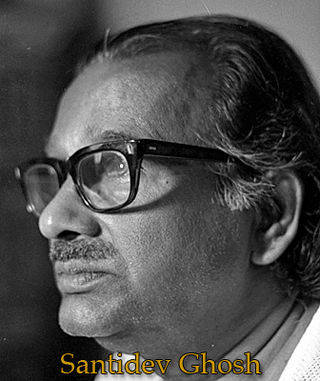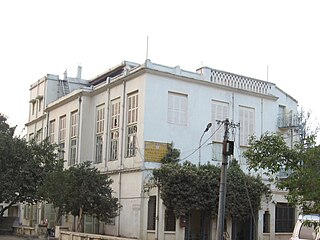
Shantiniketan is a neighbourhood of Bolpur town in the Bolpur subdivision of Birbhum district in West Bengal, India, approximately 152 km north of Kolkata. It was established by Maharshi Devendranath Tagore, and later expanded by his son, Rabindranath Tagore whose vision became what is now a university town with the creation of Visva-Bharati.

Visva-Bharati is a public central university and an Institution of National Importance located in Shantiniketan, West Bengal, India. It was founded by Rabindranath Tagore who called it Visva-Bharati, which means the communion of the world with India. Until independence it was a college. Soon after independence, the institution was given the status of a central university in 1951 by an act of the Parliament.

Kanika Banerjee was an Bengali Rabindra Sangeet singer.

Bolpur is a city and a municipality in Birbhum district in the state of West Bengal, India. It is the headquarters of the Bolpur subdivision. Bolpur municipal area includes Santiniketan, Sriniketan and Prantik. The city is known as a Cultural and Educational hub of West Bengal. The city is under the Jurisdiction of Bolpur and Santiniketan Police station. Bolpur is the largest and most populous city in Birbhum district and 28th most populous city in West Bengal. Located on the banks of Ajay River and Kopai (Sal) River, Bolpur has been a major Human settlement. It is 150 km north of Kolkata and is famous for Visva Bharati, the University set up by the Nobel laureate poet Rabindranath Tagore.

Suchitra Mitra was an Indian singer, composer, artist exponent of Rabindra Sangeet or the songs of Bengal's poet laureate Rabindranath Tagore, professor, and the first woman Sheriff of Kolkata. As an academic, she remained a professor and the Head of Rabindra Sangeet Department at the Rabindra Bharati University for many years. Mitra was a playback singer in Bengali films and was associated for many years with the Indian People's Theatre Association.

Ramkinkar Baij was an Indian sculptor and painter, one of the pioneers of modern Indian sculpture and a key figure of Contextual Modernism.
The Thakur family, with over three hundred years of history, has been one of the leading families of Calcutta, India, and is regarded as one of the key influencers during the Bengali Renaissance. The family has produced several persons who have contributed substantially in the fields of business, social and religious reformation, literature, art and music.

Santidev Ghose was an Indian author, singer, actor, dancer and maestro of Rabindra Sangeet.
Sriniketan is a neighbourhood of Surul in Bolpur subdivision of Birbhum district in the Indian state of West Bengal. It is adjacent to Santiniketan and houses the second campus of Visva-Bharati University. The Palli Samgathana Vibhag and Palli Siksha Bhavana are located in west bengal

Patha Bhavan is a mixed medium independent co-educational day school in Kolkata, India, which is affiliated to the state secondary and higher secondary boards. It was established on 28 June 1965.

Kala Bhavana is the fine arts faculty of Visva-Bharati University, in Shantiniketan, India. It is an institution of education and research in visual arts, founded in 1919, it was established by Nobel laureate Rabindranath Tagore.
Siksha Satra is a school at Sriniketan town in Birbhum district, West Bengal. Established in 1924, it functions under Visva Bharati University.

Pratima Devi (1893–1969) was an Indian Bengali artist, widely known for her artistic abilities. She was wife of Rathindranath Tagore. The poet took special interest in developing her capabilities.

Indira Devi Chaudhurani was an Indian literary figure, author and musician. Born to the Tagore family, Indira was the younger child of Satyendranath Tagore and Jnanadanandini Devi and younger sister of Surendranath Tagore. She is noted for her work in scoring the music for a number of songs by her uncle Rabindranath, with whom she was particularly close. Indira Devi Chaudhurani died in 1960.
The following is a list of notable people associated withVisva- Bharati University and/or Santiniketan, a neighbourhood in Bolpur city in West Bengal, India:

Cheena Bhavana, of Visva-Bharati University, founded in 1937, is a centre of Sino-Indian cultural studies located at Santiniketan in West Bengal, India. Its reputation as a center promoting historical study and modern relations between the two countries was built by such figures as Rabindranath Tagore and Tan Yun-Shan. The library is known for a major collection of Chinese books and journals, especially Buddhist scriptures and texts.
Tan Yun-Shan was a Chinese scholar and founder of Santiniketan's Cheena Bhavana, the oldest centre of Chinese studies in South Asia. He devoted his life to the cause of Sino-Indian cultural friendship.

Sangit Bhavana, of Visva-Bharati University, Santiniketan, started functioning as a part of Kala Bhavana in 1919 and as a separate institution in 1933. It was established by the Nobel laureate Rabindranath Tagore.

Palli Samgathana Vibhaga, of Visva-Bharati University, was established at Sriniketan in 1922, by the Nobel laureate Rabindranath Tagore. Leonard Knight Elmhirst was its first director.

Jamuna Sen was an Indian artist, known for her design work in a variety of mediums including Batik and Alpona as well as developing, in an Indian context, a variety of traditional crafts from across the world. She was a pioneer in establishing the practice of Batik in India in modern times. Daughter of Nandalal Bose, a central figure in modern Indian art, she was brought up in the artistic and intellectual milieu of Santiniketan and made significant contributions in the field of design.

















